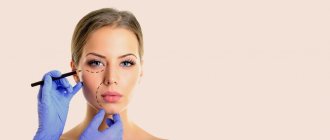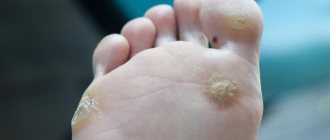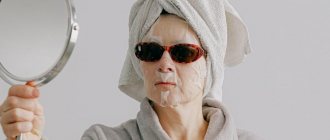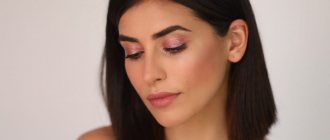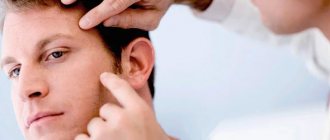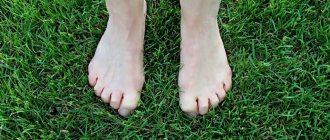What happens when you look in the mirror at 18? Having critically examined your reflection, you apply mascara to your eyelashes and remain absolutely satisfied, in a great mood. However, at 25 you have to put in a little more effort, at 30 much more, and then even more at 35...
Time, for each of us, first moves slowly, then runs, and then rapidly increases speed, and a series of events flashes before our eyes: joyful, sad, amazing, everyday, successful and not so successful.
At some point, you begin to seem to yourself like a squirrel in a wheel or a person whose coat is slammed by the door of a moving car and, in order not to get hit by the wheels, you are forced to quickly run, increasing your speed. Alone with yourself, you understand that in your soul you are still 18, well, at most 25, and in the mirror the face of a stranger is reflected, who is already 40... There are already strings of wrinkles around the eyes and on the forehead, the skin has changed color and does not look so smooth, the features have sharpened. The most important thing is that the thought that I am now successful, have a lot of experience, knowledge, and skills does not calm me down at all!
Realizing your age first brings you sadness, but after a few days you make a decision (as usual) to fight and achieve your goal. The goal is simple: to look young, attractive and well-groomed. You need a plan and tools. First, figure out: what exactly is happening to me and how to deal with it effectively with minimal investment of time, effort and money?
To determine the tactics of facial rejuvenation and who to contact first - a cosmetologist or a plastic surgeon, it is necessary to find out what type of aging the face is susceptible to. That is, the first step is to make a correct diagnosis.
So: today, the most popular classification is I.I. Kolgunenko, proposed back in 1974. This author found general patterns of age-related changes and identified six types of aging, five of them classified as early.
"Tired" type of aging
The first age-related changes appear on the face. In the morning, after a full rest, the face looks fresh, and in the evening it looks sad and tired: bags and dark circles appear under the eyes, the nasolacrimal and nasolabial furrows begin to appear, the corners of the mouth droop sadly. The shape of the face remains unchanged, although its youthful roundness has already disappeared.
The “tired” type of aging is more pronounced in women of normal or thin build, middle age with an oval or diamond-shaped face, with normal skin in youth and moderately dry skin in middle age, with average expression of the subcutaneous fat and muscle layer.
This type of aging is characterized by dryness, decreased skin turgor and elasticity. Dull, uneven, grayish complexion, swelling and pastiness are caused by impaired lymphatic drainage and blood supply, which lead to tissue hypoxia. Initial lipoatrophy (decreased thickness of the subcutaneous fat layer) and decreased tone of facial muscles leads to a decrease in the fullness of the soft tissues of the face. Age-related tissue decline has already begun, but permanent wrinkles have not yet formed.
Rejuvenation techniques for the “tired” type of aging
The “tired” of age-related changes responds gratefully to any care, so various cosmetic procedures come first in terms of efficiency and rationality, with plastic surgery joining later.
1) Cosmetic procedures aimed at improving microcirculation, improving the tone of facial muscles, stimulating the production of collagen, elastin, hyaluronic acid and restoring facial volumes:
- Competent skin care for the face and neck at home
- A visit to a cosmetologist for professional skin care for the face and neck, which will include:
- non-invasive methods (facial cleansing, massage, moisturizing, nourishing and modeling masks, superficial chemical peeling of the skin);
- physiotherapeutic methods (myostimulation, microcurrents and ultrasound therapy);
- invasive methods (biorevitalization, bioreinforcement and contouring with hyaluronic acid gels, mesotherapy with homeopathic and vitamin cocktails).
2) Surgical technique
- contour plastic surgery of the face using one’s own adipose tissue – lipofilling – to improve the quality of the skin and restore facial volumes lost due to lipoatrophy.
Sleep, air and water are best friends
Relying only on decorative cosmetics, of course, is absurd. After all, dull skin, bags under the eyes and an unhappy expression cannot be disguised even with the most expensive foundation. No need to. Provide yourself with at least 8 hours of sleep, albeit short, but still walks in the fresh air, regular exercise or at least an hour long walks at a brisk pace, as well as a contrast shower - and, you see, the mirror will become much more kind to you. Also, do not forget about proper nutrition and sufficient fluids (at least 1.5 liters per day). Eat more fresh vegetables and fruits, less fatty, floury and sweet foods - this will help regulate not only your weight, but also your stool, which is extremely important not only for the health of the digestive tract, but also for the condition of the skin.
Excess water. Why facial swelling occurs and how to deal with it Read more
"Fine wrinkled" type
This type is characterized by dystrophic changes in the skin - decreased turgor, dehydration, decreased elasticity due to the destruction of the collagen framework, decreased tone of facial muscles and lipoatrophy.
The main defining feature is a decrease in the volume of the face (which seems to “dry out” evenly) and a large number of small wrinkles on the face that persist in the absence of facial expressions: pronounced “crow’s feet” in the corners of the eyes, wrinkling of the upper and lower eyelids, “purse-string” wrinkles in areas of the upper lip and chin.
The skin of the face, neck, décolleté, shoulders, forearms and back of the hands looks dry, thinned, parchment-like, prone to irritation and rosacea. Over time, the skin becomes like a baked apple, while there is no ptosis (drooping of facial tissues) and facial contours in most cases remain clear. Most often, women of thin build with thin, dry facial skin are susceptible to age-related changes of the fine-wrinkled type.
Facial rejuvenation techniques for “fine-wrinkled” type
The “fine-wrinkle” type of aging is equally effectively helped by cosmetology and plastic surgery. The main thing is a competent combination and sequence.
1) Cosmetic procedures aimed at improving microcirculation, improving the tone of facial muscles, stimulating the production of collagen, elastin, hyaluronic acid, preventing and reducing wrinkles, restoring facial volumes:
- Competent skin care for the face and neck at home
- Regular visits to a cosmetologist for professional care of the skin of the face and neck, which will include: non-invasive methods (facial cleansing, massage, moisturizing and nourishing masks, superficial and medium chemical peels of the skin);
- physiotherapeutic methods (laser fractional rejuvenation);
- invasive methods (biorevitalization, bioreinforcement and contouring with hyaluronic acid gels; mesotherapy with homeopathic and vitamin cocktails; botulinum toxin for the prevention and elimination of wrinkles).
2) Surgical technique
- contour plastic surgery of the face using one’s own adipose tissue – lipofilling – to improve the quality of the skin and restore lost volumes of the face;
- blepharoplasty;
- laser facial resurfacing in combination with lipofilling;
- mesotherapy with autologous fibroblasts.
Dehydrated skin
This condition causes dandruff and very fine wrinkles. Comedones (blackheads) and excessive sebum production may occur. The skin on the surface feels tight, especially on the forehead and above the cheekbones.
Dehydrated skin
Dehydrated skin is very common, but it is easy to treat. It goes without saying that drinking plenty of water is important, and special care is also important.
If one or more of the following applies to you, this is a sign of dehydrated skin:
- The skin turns red, but does not seem irritated;
- The appearance is dry and small, fine lines appear, especially pronounced around the eyes, forehead and mouth. Immediately after applying the cream they are much less noticeable;
- The skin quickly absorbs care products.
“Deformation” type of aging
This type of aging is characterized by a weakening of the tone of facial muscles, a decrease in skin elasticity and swelling, pastiness due to impaired lymphatic drainage.
The main defining feature is the drooping of the soft tissues of the face and neck (ptosis), with the formation of large, deep wrinkles, which leads to deformation of the contours of the face: the oval becomes swollen, loses its clarity, bags appear above and under the eyes, jowls, double chin, deep nasolacrimal, nasolabial folds and “puppet lines” (folds of grief).
The deformational type of aging predominates in women who are prone to obesity, with well-developed subcutaneous fatty tissue - a “full” face and large facial features. As a rule, such people have thick, porous, oily skin.
Facial rejuvenation techniques for “deformation” type
In terms of effectiveness and expediency, for the “deformative” type of age-related changes, plastic surgery comes first, while cosmetology is more necessary to maintain the stability of the result.
1) Surgical technique depending on the degree of age-related changes
- blepharoplasty;
- various options for surgical facelifts;
- contour plastic surgery of individual areas of the face with one’s own adipose tissue - lipofilling - to improve the quality of the skin and restore lost volumes, most often the middle zone of the face;
- mesotherapy with autologous fibroblasts.
2) Cosmetic procedures aimed at improving microcirculation, activating lymphatic drainage, improving the tone of facial muscles, stimulating the production of collagen, elastin, hyaluronic acid, preventing and reducing wrinkles:
- Competent skin care for the face and neck at home
- A visit to a cosmetologist for professional care of the skin of the face and neck, which will include: non-invasive methods (facial cleansing, massage, moisturizing, nourishing and modeling masks, superficial and medium chemical peels of the skin);
- physiotherapeutic methods (myostimulation, microcurrent and ultrasound therapy, laser fractional rejuvenation);
- invasive methods (mesotherapy with homeopathic and vitamin cocktails, botulinum toxin to prevent the appearance and elimination of deep wrinkles and contour plastic surgery).
“Combined” type of aging
This type of aging includes a combination of various proportions of signs of fine-wrinkle and deformation types of aging, and is the most common and most common. It is characterized by the presence of fine wrinkles and deforming ptosis of soft tissues.
Such women have manifestations of decreased turgor and wrinkling on the face and neck, combined with deformation of soft tissues. Combination (mixed) skin. In such cases, fine wrinkles and dry atrophic skin predominate on the forehead and around the eyes, combined with bags above and below the eyes, an unclear oval of the face, jowls, deep nasolabial and “puppet” wrinkles.
Facial rejuvenation techniques for “combined” type of aging
For the “combined” type, a competent combination and alternation of cosmetic procedures and plastic surgeries is effective.
1) Cosmetic procedures aimed at improving microcirculation, activating lymphatic drainage, improving the tone of facial muscles, stimulating the production of collagen, elastin, hyaluronic acid, restoring facial volume, preventing and reducing wrinkles:
- Competent care for the skin of the face and neck at home;
- A visit to a cosmetologist for professional care of the skin of the face and neck, which will include: non-invasive methods (facial cleansing, massage, moisturizing, nourishing and modeling masks, superficial and medium chemical peels of the skin);
- physiotherapeutic methods (myostimulation, microcurrent and ultrasound therapy, laser fractional rejuvenation);
- invasive methods (biorevitalization, bioreinforcement and contouring with hyaluronic acid; mesotherapy with homeopathic and vitamin cocktails; botulinum toxin for the prevention and elimination of wrinkles of varying depths).
2) Surgical technique depending on the severity of age-related changes:
- blepharoplasty;
- various options for surgical facelifts;
- contour plastic surgery of the face using one's own adipose tissue - lipofilling - to improve the quality of the skin and restore lost volumes in the middle zone of the face;
- laser facial resurfacing alone or in combination with lipofilling;
- mesotherapy with autologous fibroblasts.
"Muscular" type of aging
It is typical for women and men with developed facial muscles and poorly defined subcutaneous fat tissue. The skin of such people is dense, firmly fused to the underlying tissues, does not move, and retains elasticity for a long time, which explains the fact that age-related changes do not make themselves felt for a long time.
Aging manifests itself in connection with progressive lipoatrophy, as a result of which the face “dries out” and deep wrinkles form.
The muscular type of aging is more common among residents of Central Asia and the Far East: with age, their pigmentation is disrupted, deep wrinkles form on the forehead, in the corners of the mouth, nasolabial folds, and facial features become aggravated. At the same time, the skin of the cheeks remains smooth and even, and the contour of the oval of the face remains clear for a long time.
Rejuvenation techniques for “muscular” type of aging
For the “muscular” type, a competent combination and alternation of cosmetic procedures and plastic surgeries is effective.
1) Cosmetological procedures aimed at improving microcirculation, activating stimulation of the production of collagen, elastin, hyaluronic acid, preventing and reducing wrinkles:
- Competent care for the skin of the face and neck at home;
- A visit to a cosmetologist for professional skin care for the face and neck, which will include: non-invasive methods (facial cleansing, massage, medium-length chemical skin peels);
- invasive methods (mesotherapy with homeopathic and vitamin cocktails; botulinum toxin to prevent the appearance and elimination of wrinkles; contouring with hyaluronic acid gels).
2) Surgical technique depending on the severity of age-related changes:
- blepharoplasty;
- various options for surgical facelifts in combination with lipofilling;
- contour plastic surgery of the face using one’s own adipose tissue – lipofilling – to improve the quality of the skin and restore lost volumes of the face;
- laser facial resurfacing combined with liposuction;
- mesotherapy with autologous fibroblasts.
The role of proper nutrition in skin care
Proper nutrition is the basis for the healthy functioning of the body. After all, vitamins and minerals, essential acids and fats penetrate into the bloodstream through the intestines.
At 35 years old, you need to change your usual diet and consume more of the following foods:
- Vegetable oils from flax, hemp, olive - they are enriched with vitamins and do not allow the accumulation of fat deposits.
- Fatty fish. Enriches the body with vitamin D and B vitamins, Omega-3 fatty acids and Se.
- Beans, tomatoes, flax seeds. From the age of 35, a woman’s body produces less phytoestrogen (female hormone), which is responsible for beauty and youth. These products replenish the hormone deficiency.
- Fruit and vegetable products. Source of vitamins and nutrients.
- Soy. Indispensable for preventing aging of the body.
- Fermented milk products, cottage cheese 1%, natural yogurt.
But it is correct to avoid strong alcoholic and carbonated drinks, limit the consumption of coffee and very strong tea. Soda and fast food are not recommended at all.
You should not go on mono-diets after 35 years, as this negatively affects the condition of the dermis. The skin will be flabby, sagging, and if you don’t exercise, the result will not be pleasing.
It is important not to abuse alcohol, stop smoking, get enough sleep and maintain hormone balance. Therefore, proper nutrition is the path to beauty and health for a woman.
Type of aging “senile, emaciated face”
The “senile, worn-out face” is the sixth type of aging, which is the late stage of all types of aging. This is the period when all the signs of aging appear, and in this case only plastic surgery can radically help: namely, a one-stage combination or stage-by-stage surgical facelift, blepharoplasty with lipofilling and laser resurfacing.
Whatever your type of aging, the Abrielle aesthetic surgery clinic will help you look great at any age.
You can learn more about rejuvenation methods for your type of aging during a consultation with a cosmetologist or plastic surgeon at the Abrielle Aesthetic Surgery Clinic. To schedule a consultation, call the clinic and 8(921)99-22-335.
Irritated skin
Irritation can occur in all skin types and manifests itself in different ways from time to time. There are many reasons for this: temperature changes, exposure to the sun, food, diet, touch, bacteria and much more.
If one or more of the following descriptions apply to you, this is a sign that your skin is currently irritated:
- The skin suddenly turns red;
- Suddenly becomes warm;
- There is itching, tingling or burning;
- Suddenly a lot of pimples appear - even where there are usually none.

